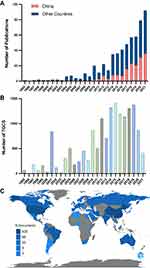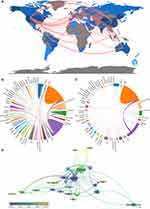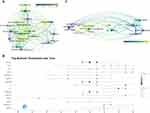Back to Journals » Infection and Drug Resistance » Volume 16
Global Trends in Research of Antimicrobial Peptides for the Treatment of Drug-Resistant Bacteria from 1995 to 2021: A Bibliometric Analysis
Authors Liang Y , Huang Z, Shen X, Zhang Y, Chai Y, Jiang K, Chen Q, Zhao F
Received 5 March 2023
Accepted for publication 1 June 2023
Published 24 July 2023 Volume 2023:16 Pages 4789—4806
DOI https://doi.org/10.2147/IDR.S411222
Checked for plagiarism Yes
Review by Single anonymous peer review
Peer reviewer comments 2
Editor who approved publication: Prof. Dr. Héctor Mora-Montes
Yuelong Liang,1,* Zhengze Huang,1,* Xuqiu Shen,1,* Yiyin Zhang,1 Yihan Chai,1 Kexin Jiang,1 Qi Chen,2 Feng Zhao3
1Department of General Surgery, Sir Run Run Shaw Hospital, School of Medicine, Zhejiang University, Hangzhou, Zhejiang, People’s Republic of China; 2Department of General Surgery, Hangzhou Fuyang Hospital of Traditional Chinese Medicine, Hangzhou, Zhejiang, People’s Republic of China; 3Department of Clinical Laboratory, Sir Run Run Shaw Hospital, School of Medicine, Zhejiang University, Hangzhou, Zhejiang, People’s Republic of China
*These authors contributed equally to this work
Correspondence: Yuelong Liang; Feng Zhao, Email [email protected]; [email protected]
Background: Antimicrobial peptides (AMPs) can act on the bacterial cell membrane to play an antibacterial role in types of drug-resistant bacteria. Therefore, AMPs have attracted more and more attention in the treatment of drug-resistant bacteria.
Methods: Bibliometric analysis was employed to sort out the development and trends in the research of AMPs in the treatment of drug-resistant bacteria and map the knowledge structure for scholars.
Results: Since 2010, the publications and citations in this field have exploded, indicating a growing global interest in the field of AMPs for the treatment of drug-resistant bacteria. And as major countries in this field, China and the USA had conducted very in-depth exchanges and cooperation, which had injected a steady stream of impetus into this field. Both old and new scholars have made efforts, and related fields have developed rapidly, especially in the synthesis and improvement of novel AMPs. In recent years, research directions in the field of AMPs for the treatment of drug-resistant bacteria gradually focused on the practical application, optimization of drug delivery mode, optimization of synthesis mode, screening of new AMPs and other fields, indicating that the relevant research results of AMPs for the treatment of drug-resistant bacteria had entered the actual clinical stage, with higher practical significance.
Conclusion: The research history, global research status, future research hotspots, and trends of the research of AMPs in the treatment of drug-resistant bacteria were discussed in depth in this study, which can provide research references and inspiration for researchers inside and outside the related field.
Keywords: antimicrobial peptides, AMP, drug-resistant bacteria, bibliometric
Introduction
Due to the abuse of antibiotics worldwide, drug-resistant bacteria have become an important threat to global health.1 It is predicted that by 2050, more than 10 million people worldwide will die from infections caused by drug-resistant bacteria.2 Therefore, there is an urgent need to find or design an antimicrobial agent that is less susceptible to resistance challenges than traditional antibiotics.3
The concept of antimicrobial peptides (AMPs) became popular in the 1990s.4 They are a certain type of small molecular peptides with antibacterial biological activity and play a key role in the innate immunity of the body to a variety of microorganisms.5,6 AMPs can damage bacterial cell membranes through electrostatic interaction,7 thus playing an antibacterial role. Several modes have been used to explain the process of AMPs breaking bacterial cell membranes, including the barrel-stave model, toroidal-pore model, disordered toroidal-pore model, carpet model, and detergent-like model.7–11 Meanwhile, AMPs can also assist their own antibacterial role by regulating immune response and inflammation levels.12 It is generally believed that the difference in cell membrane composition between pathogen and host cell is the basis for the pathogen-targeting specificity of AMPs. Because the cell membrane of pathogenic bacteria usually contains negatively charged phosphatidylcholine, phosphatidylglycerol, etc.,13 the positively charged AMPs can interact with the negatively charged membrane of pathogenic bacteria through electrostatic force, resulting in the destruction of the bacterial cell membrane and the death of bacteria. This physical action characteristic also results in AMPs being less affected by drug resistance and have relatively broad-spectrum antibacterial activity,3 thus making AMPs an advantageous choice for the treatment of drug-resistant bacteria,14,15 including so-called dangerous multidrug-resistant (MDR) bacteria.16
Bibliometric is a method to obtain the history and progress of relevant research in this field through a comprehensive analysis of relevant publications.17 Bibliometric enables researchers in and out of related research fields to quickly understand and grasp the changes in research trends, as well as the latest research hotspots, so as to help researchers acquire cutting-edge knowledge in the field and develop research plans. Herein, we conducted a bibliometric analysis of the published literature on the field of AMPs in the treatment of drug-resistant bacteria, to help scholars showcasing related developments and forecasting future trends.
Materials and Methods
Data Sources and Filtering Strategies
Using the Web of Science Core Collection (WoSCC) database, we searched for literature on AMPs and drug-resistant bacteria among publications published between January 1st, 1995 and December 31st, 2021. All literature retrieval and export work were completed within one day (November 21st, 2022) to avoid the fluctuation of publication data caused by the rapid update of the database, especially the citation data. We set the retrieval formula to TS = (antimicrobial peptide OR AMP) AND TS = (drug-resistant bacteria) and obtained 974 publications. Through the screening process shown in Figure 1, we eventually included 560 articles in our study. We exported detailed information on these articles, including the volume of publications, the number of citations, the year of publication, authors, institutions, countries, titles, keywords, references, etc., for subsequent processing and analysis. Detailed information about these 560 articles can be viewed in Supplementary Table 1.
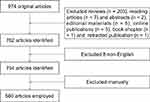 |
Figure 1 Flowchart of the screening process. |
Statistical Analysis
All the exported data were processed and analyzed by Microsoft Excel for Mac (version 16.67), bibliometric.com, VOSviewer (version 1.6.18), Prism 9, Bibliometrix Packages based on R (version 4.2.2) and RStudio (version 2022.07.2), and HistCite (version 2009.08.24).
Microsoft Excel for Mac was used for data calculation, processing, and analysis. The website bibliometric.com was used to count the number of publications published over the years, collaborations between countries and the influence of different institutions, authors, and journals. VOSviewer was employed to visualize data and generate collaborative networks between countries, institutions, authors, and journals. The size of nodes represents the number of publications, the thickness of the lines between nodes represents the closeness of the relationship, and a difference in node color indicates a change in time or a change in the cluster. VOSviewer was used to generate a co-occurrence network of keywords. Prism 9 was used to visualize the number of publications over time and the differences in volume and citations across countries and regions. Bibliometrix Packages based on R were used to make detailed statistics and analysis of data such as authors, institutions, countries, topics, and other data, as well as data visualization. HistCite (version 2009.08.24) was hired to calculate the number of publications and total global citation score (TGCS, the number of times the article was cited by all literature in the entire WoS database) between different countries, institutions, authors, and journals.
Results
Overview of Overall Publications and Citations
After screening, we finally obtained 560 publications. Curve fitting analysis (Figure 2A) suggested that the annual publication volume of AMPs for the treatment of drug-resistant bacteria had continued to increase since 1995, with an annual growth rate of 19%. Specifically, from 1995 to 2009, no more than 10 articles were published each year on the research of AMPs for the treatment of drug-resistant bacteria. Since 2010, the number of articles published in this field had increased significantly, and the annual growth rate was also on the rise. In particular, the number of publications in 2021 (n = 92) was even more than that of the 17 years (n = 78) from 1995 to 2011 combined, and almost as much as the previous 18 years combined (1995–2012, n = 100). Specifically, early studies focused on the structure and mechanism of then-known AMPs, such as cecropin and melittin, or the screening of novel AMPs.18–22 From the perspective of China, where the research team is located, the number of articles in the field of AMPs for the treatment of drug-resistant bacteria was increasing year by year, which was consistent with the global trend (Figure 2A), and the proportion of annual publication from China was also on the rise. Despite the fluctuations in citations over the past few years, the annual TGCS showed an increasing trend (Figure 2B), which, together with the annual publication volume, revealed a growing global interest in the field of AMPs for the treatment of drug-resistant bacteria. The global distribution of total publications in this field is shown in Figure 2C, with most publications published by North American, European, and East Asian countries, such as the USA and China.
Contributions and Cooperation Networks of Different Countries
From 1995 to 2021, a total of 49 countries conducted research on AMPs for the treatment of drug-resistant bacteria (Figure 2C). The top 10 countries in terms of article output are shown in Figure 3A. Among them, China published the most articles, 420 in total, while the USA (n = 299) and South Korea (n = 121) ranked second and third, respectively. Figure 3B shows the production of the top 5 productive countries over time and revealed China’s rapid progress in the field of AMPs for the treatment of drug-resistant bacteria. In 2018, China’s cumulative publication volume in this field equaled that of the USA, reaching 178, and surpassed the USA in the following years. From the perspective of TGCS, the top 10 countries with the most cited published studies are shown in Figure 3C, among which the USA (n = 5054) ranked first, China (n = 3674) ranked second, and India (n = 1229) ranked third.
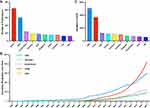 |
Figure 3 Analysis of countries. (A) Bar chart of the top 10 productive countries; (B) Top 5 countries’ production over time; (C) Bar chart of TGCS of the top 10 productive countries. |
In view of the devastation caused by drug-resistant bacteria worldwide, countries around the world had extensive cooperation in the field of AMPs for the treatment of drug-resistant bacteria. The cooperation network of countries around the world is shown in Figure 4A and B, where the thickness of the lines indicated the closeness of cooperation. From the perspective of China, which had the largest output of articles, it had the closest cooperation with the USA, which had the second largest output of articles in the world, and also had a relatively close relationship with Singapore and Canada (Figure 4C). In contrast, China had less cooperation with South Korea, the world’s third-largest producer of articles in this field. Figure 4D shows the time of cooperation between countries with equal to or more than 5 publications on the basis of the degree of cooperation. The size of nodes represented the amount of publication, the line thickness between nodes revealed the closeness of cooperation, and the color of nodes and lines represented the time relationship of cooperation. Consistent with Figure 4D, the USA led the trend of cooperation in the field of AMPs for the treatment of drug-resistant bacteria worldwide since 2015. Subsequently, China also initiated close exchanges and cooperation with most countries since 2018, among which the cooperation between China and the USA was the closest. It could be found that countries with a high number of publications in this field tended to have closer cooperation with foreign countries, which suggested that the research of AMPs for the treatment of drug-resistant bacteria had become a hot spot all over the world, and the progress in this field also depended on the full cooperation of researchers from different countries.
Contributions and Cooperation Networks of Institutions and Authors
From 1995 to 2021, a total of 817 institutions participated in the research of AMPs in the treatment of drug-resistant bacteria, and the top 20 productive institutions are listed in Table 1. Specifically, the Chinese Academy of Sciences (n = 22) had the highest output, while Chosun University (n = 17) and the National University of Singapore (n = 12) ranked second and third, respectively. Visualizing the collaboration networks of the top 20 institutions revealed that there was less collaboration between the top 3 institutions. Among them, the cooperation between the Chinese Academy of Sciences and other institutions occurred recently, while the cooperation between the National University of Singapore and other institutions took place earlier, as did the Chosun University (Figure 5A). We believed that top institutions should strengthen their cooperation, which was in line with the development trend of the current research field, and can promote the integration and maximum utilization of resources through the combination of strong institutions, so as to obtain more outstanding results.
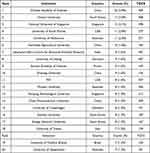 |
Table 1 The Top 20 Productive Institutions Concerning AMPs in the Treatment of Drug-Resistant Bacteria |
From 1995 to 2021, a total of 3054 authors participated in the research on AMPs for the treatment of drug-resistant bacteria. Table 2 lists the top 15 authors in terms of output. Haldar J and Park Y were the most prolific authors with 12 articles published, while Cai JF ranked third with 11 articles published. Park Y had carried out a lot of research work on different AMPs and verified the unique effectiveness of AMPs against drug-resistant bacteria. Cai JF and his team focused on the research and development of AMPs and the design of peptidomimetics and tried to optimize and upgrade the effectiveness of AMPs by using nanoengineering. Haldar J (cited 707 times) was also the most cited author among the top 15 authors, followed by Konai MM (cited 547 times) and Samaddar S (cited 441 times). They were from the Jawaharlal Nehru Centre for Advanced Scientific Research, India. Haldar J’s research focused on antimicrobial resistance, the development of novel antimicrobial agents (including AMPs and their mimics), and the material application of AMPs (such as antibacterial coatings).
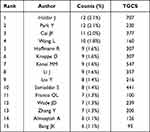 |
Table 2 The Top 15 Prolific Authors Concerning AMPs in the Treatment of Drug-Resistant Bacteria |
Figure 5B shows the publication schedules of the top 15 prolific authors. It was worth noting that Wade JD has been involved in the field for more than 15 years since publishing his first paper on AMPs for the treatment of drug-resistant bacteria in 2005. Liu Y and Almaaytah A only started working in this field in 2017, but they had already made considerable progress. Liu Y had carried out many studies on multi-drug resistant bacteria, among which the application of AMPs had become one of the highlights of her research. Almaaytah A focused on the synergistic antibacterial action of AMPs with other drugs and had made good progress in the development of ultrashort AMPs. Figure 5C reveals the collaborative network among the top 15 authors. Haldar J, Cai JF, and Park Y had extensive exchanges and cooperation with other researchers. From the perspective of time, most of the exchanges and cooperation carried out by Haldar J occurred around 2015, while most of the cooperation among Cai JF, Park Y, and other authors occurred in 2017 and later.
Analysis of Journals
From 1995 to 2021, a total of 220 journals published articles on AMPs in the treatment of drug-resistant bacteria. Table 3 shows a list of the top 18 journals by volume. Antimicrobial Agents and Chemotherapy topped the list with 28 publications, Journal of Medicinal Chemistry and Frontiers in Microbiology ranked the second and third with 23 and 19 articles, respectively (Figure 6A). In terms of citations, Antimicrobial Agents and Chemotherapy (1538 times), Journal of Medicinal Chemistry (887 times), and Biomaterials (836 times) ranked in the top 3. The visualization of the co-citation of the journal citation revealed that Biomaterials Science and ACS Applied Materials & Interfaces were the most popular journals in the field of AMPs for the treatment of drug-resistant bacteria in recent years (Figure 6B).
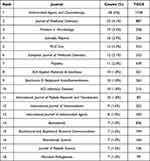 |
Table 3 The Top 18 Journals with the Highest Number of Articles Concerning AMPs in the Treatment of Drug-Resistant Bacteria |
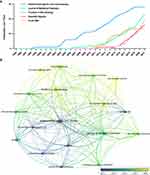 |
Figure 6 Analysis of journals. (A) Top 5 journals’ number of publications over time; (B) The visualization of co-citation and time evolution of the top 18 journals. |
Most Cited Papers
Scientific research is often exploring new worlds on the shoulders of giants, and citations are an important indicator of an article’s influence in the field. Herein, we listed the top 20 most cited articles in Table 4. The most cited article (787 citations) was entitled Antibacterial agents based on the cyclic D, L-alpha-peptide architecture (https://doi.org/10.1038/35086601) produced by Fernandez-Lopez et al and published on Nature in 2001. This article introduced the bacterial selectivity of cyclic AMPs and verified their killing effect against methicillin-resistant Staphylococcus aureus (MRSA), which provided a novel research direction for the structural study of AMPs.23 Moreover, this article also had the highest annual citations (35.77 times per year) (Table 4).
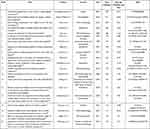 |
Table 4 The 20 Most Cited Articles (Sorted by Total Citation) Concerning AMPs in the Treatment of Drug-Resistant Bacteria |
Analysis of Keywords
The proportion and evolution of keywords can reflect the emphases and changes of the research field, helping us understand the development and trend of the field, and predicting the possible research hotspots in the future. Herein, we used VOSviewer to generate a co-occurrence knowledge network of keywords (Figure 7A). A total of 98 terms that had appeared 10 times or more in the titles and abstracts of all articles were selected, which were divided into 6 clusters and distinguished by 6 colors. There were four distinct clusters, denoted by red, green, blue, and yellow. The red cluster accounted for the largest proportion, which was mainly related to the structure, mechanism, and design of AMPs. And typical keywords included in the red cluster were “membrane”, “polymers”, “design”, “oligomers”, and “derivatives”. In addition, the green cluster mainly focused on the practical application of AMPs in the treatment of drug-resistant bacteria, and its keywords include “MRSA”, “drug-delivery”, “efficacy”, “therapy” and “cytotoxicity”. Likewise, the blue cluster and the yellow cluster were mainly focused on the interaction between AMPs and drug-resistant bacteria, and the discovery of novel AMPs. The top 50 keywords with the highest frequency are shown in Figure 7B.
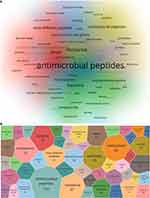 |
Figure 7 Analysis of keywords. (A) Keywords co-occurrence network of AMPs for the treatment of drug-resistant bacteria; (B) The voronoi treemap of the top 50 keywords. |
Figure 8A reveals the changes of keywords before and after 2010. Since 2010, the term “antimicrobial peptides” had been strengthened and consolidated. Simultaneously, more attention had been paid to the research on AMP analogs and new synthesis techniques. The increased focus on drug-resistant bacteria was also a feature of this field of research since 2010 (Figure 8A). Specifically, the discovery and prediction of novel AMPs were receiving increasing attention, which to some extent reflected the tremendous pressure that the rapid development of drug-resistant bacteria was putting on the healthcare system (Figure 8B). Figure 8B also suggests that the combination of AMPs with nanoparticles and other nanomaterials had become a new direction of research on AMPs in the treatment of drug-resistant bacteria, such as “surface”, “nanoparticles”, and “binding”.
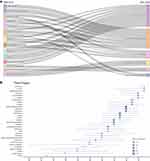 |
Figure 8 Analysis of keywords. (A) The thematic evolution of keywords before and after 2010; (B) The trend of keywords from 1995 to 2021. |
Discussion and Conclusion
In this study, we used bibliometrics to analyze related studies on AMPs in the treatment of drug-resistant bacteria. We selected articles published in English between 1995 and 2021 as analysis objects and reviewed the history of relevant research on specific dimensions. We visualized the research in terms of publications, citations, countries/regions, institutions, authors, journals, keywords, etc. Our research results will help people who have first contact with this field quickly understand the development history and the latest research direction of this field, so as to lower the threshold to enter this field. Meanwhile, for researchers in this field, we hope to provide them with inspiration for future research and better organize their own research ideas.
China and other developing countries have increased their influence and international cooperation still needs to be strengthened. Since 2010, the publications and citations in this field have exploded, indicating a growing global interest in the field of AMPs for the treatment of drug-resistant bacteria. And as major countries in this field, China and the USA had conducted very in-depth exchanges and cooperation, which had injected a steady stream of impetus into this field. Professor Cai JF, as a central figure, has facilitated many collaborations between China and the USA on the field of AMPs for the treatment of drug-resistant bacteria.41–44 However, it was worth noting that China and South Korea, as geographically close countries with important influence in this field, still had a lot of room for progress in the cooperation and exchanges between research institutions and researchers of the two countries. From the perspective of research institutions, the Chinese Academy of Sciences, the Chosun University, and the National University of Singapore were in leading positions in this field, but the cooperation and exchanges among the 3 research institutions were still not close enough, which had a high room for improvement. There was no doubt that the USA, as a pioneer country in the field of AMPs for the treatment of drug-resistant bacteria, had the highest degree of internationalization and maintains close cooperation with all countries in the world.
Both old and new scholars have made efforts, and related fields have developed rapidly, especially in the synthesis and improvement of novel AMPs. For example, Professor Cai JF has been paying attention to the design, synthesis and research of new synthetic polypeptide structure AApeptide for a long time, hoping to screen out effective structures that can play an antibacterial role and assemble them into different functional materials for application. The antibacterial activity of lipo-γ-AApeptides was improved by introducing unsaturated lipid chain into AApeptide.45 Professor Haldar J discussed the influence of hydrophobicity variation in the building blocks of AMPs (namely amino acids) on the antibacterial efficacy of AMPs, which was verified in drug-resistant Acinetobacter baumannii, providing a new idea and direction for the research in the field of AMPs for the treatment of drug-resistant bacteria.46 Professor Liu Y, as a young scholar, has made rapid progress in the field of AMPs in the treatment of drug-resistant bacteria in recent years. Inspired by the AMP bacaucin, he designed a ring-opened heptapeptide (bacaucin-1), which can play a good killing effect on MRSA and avoid the biological toxicity of bacaucin, and has high application value.47 Similar to Professor Liu Y, Professor Almaaytah A has studied this field for a relatively short time, but he has made great achievements in the direction of ultrashort AMPs and AMPs combined with other antibacterial agents. For example, the novel ultrashort AMP alapropoginine designed by him can effectively kill MRSA when combined with conventional antibiotics.48 In conclusion, in the field of AMPs for the treatment of drug-resistant bacteria, older and younger generations of scientists are competing with each other and using their strengths to advance each other and the field of research.
The application and optimization of AMPs have gradually become a research hotspot. Antimicrobial Agents and Chemotherapy, Journal of Medicinal Chemistry, Frontiers in Microbiology were well-known journals in this field. They published a large number of articles in this field and made a great contribution to promoting the research progress of AMPs for the treatment of drug-resistant bacteria. At the same time, more and more journals paid attention to related research progress in this field, including ACS Applied Materials & Interfaces, Biomaterials, and the International Journal of Antimicrobial Agents. Through the analysis of keywords, we found that in recent years, research directions in the field of AMPs for the treatment of drug-resistant bacteria gradually focused on the practical application, optimization of drug delivery mode, optimization of synthesis mode, screening of new AMPs and other fields, indicating that the relevant research results of AMPs for the treatment of drug-resistant bacteria had entered the actual clinical stage, with higher practical significance. For example, Fichman G achieved superior practical antibacterial value by designing a novel AMP derived from mussels into an antibacterial adhesive hydrogel.49 Although the research on AMPs for the treatment of drug-resistant bacteria was constantly developing, it also reflected the increasing threat of drug-resistant bacteria to human society from the side, and we should invest more attention and energy in this field.
As common pathogens causing nosocomial infections, Acinetobacter baumannii, Pseudomonas aeruginosa, Klebsiella pneumoniae, Staphylococcus aureus and other bacteria have developed multi-drug resistance, and many traditional antibiotics have been unable to effectively kill these bacteria.15 The WHO has included these pathogens in the priority list of new drug development. Due to its special mechanism of action, AMPs have been applied in the treatment of MRD alone or in combination. The results of our study showed the growth of research on AMPs of MRDS, reflected the change of research trend, and provided researchers with ideas for future research.
Although we had analyzed and summarized the development of research on AMPs for the treatment of drug-resistant bacteria through objective and comprehensive bibliometric analysis methods as far as possible, there were still inevitable limitations. First of all, although we had collected as comprehensive literature as possible, there were still some articles not included in the analysis system considering the limitations of the team capacity, which may cause deviation or error in the analysis results. Meanwhile, due to the rapid development of related research fields, it was difficult for us to include part of the latest research results in this study. In addition, due to the use of a variety of analysis software in this study, the algorithm differences among them may also lead to certain deficiencies in the consistency of the research results.
Funding
This work was supported by the Zhejiang Province Medical and public health projects(2022522045).
Disclosure
The authors report no conflicts of interest in this work.
References
1. Munita JM, Arias CA. Mechanisms of antibiotic resistance. Microbiol Spectr. 2016;4(2). doi:10.1128/microbiolspec.VMBF-0016-2015
2. Hutchings MI, Truman AW, Wilkinson B. Antibiotics: past, present and future. Curr Opin Microbiol. 2019;51:72–80. doi:10.1016/j.mib.2019.10.008
3. Magana M, Pushpanathan M, Santos AL, et al. The value of antimicrobial peptides in the age of resistance. Lancet Infect Dis. 2020;20(9):e216–e230. doi:10.1016/S1473-3099(20)30327-3
4. Lemaitre B, Nicolas E, Michaut L, Reichhart JM, Hoffmann JA. The dorsoventral regulatory gene cassette spätzle/Toll/cactus controls the potent antifungal response in Drosophila adults. Cell. 1996;86(6):973–983. doi:10.1016/S0092-8674(00)80172-5
5. Wang J, Dou X, Song J, et al. Antimicrobial peptides: promising alternatives in the post feeding antibiotic era. Med Res Rev. 2019;39(3):831–859. doi:10.1002/med.21542
6. Mohammed I, Said DG, Dua HS. Human antimicrobial peptides in ocular surface defense. Prog Retin Eye Res. 2017;61:1.
7. Zasloff M. Antimicrobial peptides of multicellular organisms. Nature. 2002;415(6870):389–395. doi:10.1038/415389a
8. Chen JJ, Schmucker LN, Visco DP. Pharmaceutical machine learning: virtual high-throughput screens identifying promising and economical small molecule inhibitors of complement factor C1s. Biomolecules. 2018;8(2):24. doi:10.3390/biom8020024
9. Yeaman MR, Yount NY. Mechanisms of antimicrobial peptide action and resistance. Pharmacol Rev. 2003;55(1):27–55. doi:10.1124/pr.55.1.2
10. Kabelka I, Vácha R. Advances in molecular understanding of α-helical membrane-active peptides. Acc Chem Res. 2021;54(9):2196–2204. doi:10.1021/acs.accounts.1c00047
11. Ludtke SJ, He K, Heller WT, Harroun TA, Yang L, Huang HW. Membrane pores induced by magainin. Biochemistry. 1996;35(43):13723–13728. doi:10.1021/bi9620621
12. Mookherjee N, Hancock REW. Cationic host defence peptides: innate immune regulatory peptides as a novel approach for treating infections. Cell Mol Life Sci. 2007;64(7–8):922–933. doi:10.1007/s00018-007-6475-6
13. Enoki TA, Moreira-Silva I, Lorenzon EN, et al. Antimicrobial peptide K-W-Hya1 induces stable structurally modified lipid domains in anionic membranes. Langmuir. 2018;34(5):2014–2025. doi:10.1021/acs.langmuir.7b03408
14. Zhang QY, Yan ZB, Meng YM, et al. Antimicrobial peptides: mechanism of action, activity and clinical potential. Mil Med Res. 2021;8(1):48. doi:10.1186/s40779-021-00343-2
15. Roque-Borda CA, Bento da Silva P, Rodrigues MC, et al. Pharmaceutical nanotechnology: antimicrobial peptides as potential new drugs against WHO list of critical, high, and medium priority bacteria. Eur J Med Chem. 2022;241:114640. doi:10.1016/j.ejmech.2022.114640
16. Roque-Borda CA, da Silva PB, Rodrigues MC, et al. Challenge in the discovery of new drugs: antimicrobial peptides against WHO-list of critical and high-priority bacteria. Pharmaceutics. 2021;13(6):773. doi:10.3390/pharmaceutics13060773
17. Smith DR. Bibliometrics, dermatology and contact dermatitis. Contact Dermatitis. 2008;59(3):133–136. doi:10.1111/j.1600-0536.2008.01405.x
18. Merrifield EL, Mitchell SA, Ubach J, Boman HG, Andreu D, Merrifield RB. D-enantiomers of 15-residue cecropin A-melittin hybrids. Int J Pept Protein Res. 1995;46(3–4):214–220. doi:10.1111/j.1399-3011.1995.tb00592.x
19. Oren Z, Hong J, Shai Y. A repertoire of novel antibacterial diastereomeric peptides with selective cytolytic activity. J Biol Chem. 1997;272(23):14643–14649. doi:10.1074/jbc.272.23.14643
20. Roychoudhury S, Blondelle SE, Collins SM, et al. Use of combinatorial library screening to identify inhibitors of a bacterial two-component signal transduction kinase. Mol Divers. 1998;4(3):173–182. doi:10.1023/A:1009695718427
21. Mayo KH, Haseman J, Ilyina E, Gray B. Designed beta-sheet-forming peptide 33mers with potent human bactericidal/permeability increasing protein-like bactericidal and endotoxin neutralizing activities. Biochim Biophys Acta. 1998;1425(1):81–92. doi:10.1016/S0304-4165(98)00053-1
22. Friedrich C, Scott MG, Karunaratne N, Yan H, Hancock RE. Salt-resistant alpha-helical cationic antimicrobial peptides. Antimicrob Agents Chemother. 1999;43(7):1542–1548. doi:10.1128/AAC.43.7.1542
23. Fernandez-Lopez S, Kim HS, Choi EC, et al. Antibacterial agents based on the cyclic D, L-alpha-peptide architecture. Nature. 2001;412(6845):452–455. doi:10.1038/35086601
24. de la Fuente-Núñez C, Reffuveille F, Haney EF, Straus SK, Hancock REW. Broad-spectrum anti-biofilm peptide that targets a cellular stress response. PLoS Pathog. 2014;10(5):e1004152. doi:10.1371/journal.ppat.1004152
25. Velkov T, Roberts KD, Nation RL, Thompson PE, Li J. Pharmacology of polymyxins: new insights into an ‘old’ class of antibiotics. Future Microbiol. 2013;8(6):711–724. doi:10.2217/fmb.13.39
26. Shukla A, Fleming KE, Chuang HF, et al. Controlling the release of peptide antimicrobial agents from surfaces. Biomaterials. 2010;31(8):2348–2357. doi:10.1016/j.biomaterials.2009.11.082
27. Lata S, Sharma BK, Raghava GPS. Analysis and prediction of antibacterial peptides. BMC Bioinform. 2007;8:263. doi:10.1186/1471-2105-8-263
28. Veiga AS, Sinthuvanich C, Gaspar D, Franquelim HG, Castanho MA, Schneider JP. Arginine-rich self-assembling peptides as potent antibacterial gels. Biomaterials. 2012;33(35):8907–8916. doi:10.1016/j.biomaterials.2012.08.046
29. Ghosh C, Manjunath GB, Akkapeddi P, et al. Small molecular antibacterial peptoid mimics: the simpler the better! J Med Chem. 2014;57(4):1428–1436. doi:10.1021/jm401680a
30. Field D, Begley M, O’Connor PM, et al. Bioengineered nisin A derivatives with enhanced activity against both Gram positive and Gram negative pathogens. PLoS One. 2012;7(10):e46884. doi:10.1371/journal.pone.0046884
31. Wiradharma N, Khoe U, Hauser CAE, Seow SV, Zhang S, Yang YY. Synthetic cationic amphiphilic α-helical peptides as antimicrobial agents. Biomaterials. 2011;32(8):2204–2212. doi:10.1016/j.biomaterials.2010.11.054
32. Lata S, Mishra NK, Raghava GPS. AntiBP2: improved version of antibacterial peptide prediction. BMC Bioinform. 2010;11(Suppl 1):S19. doi:10.1186/1471-2105-11-S1-S19
33. Dartois V, Sanchez-Quesada J, Cabezas E, et al. Systemic antibacterial activity of novel synthetic cyclic peptides. Antimicrob Agents Chemother. 2005;49(8):3302–3310. doi:10.1128/AAC.49.8.3302-3310.2005
34. Xiong M, Lee MW, Mansbach RA, et al. Helical antimicrobial polypeptides with radial amphiphilicity. Proc Natl Acad Sci U S A. 2015;112(43):13155–13160. doi:10.1073/pnas.1507893112
35. Zhou J, Yao D, Qian Z, et al. Bacteria-responsive intelligent wound dressing: simultaneous In situ detection and inhibition of bacterial infection for accelerated wound healing. Biomaterials. 2018;161:11–23. doi:10.1016/j.biomaterials.2018.01.024
36. Deslouches B, Islam K, Craigo JK, Paranjape SM, Montelaro RC, Mietzner TA. Activity of the de novo engineered antimicrobial peptide WLBU2 against Pseudomonas aeruginosa in human serum and whole blood: implications for systemic applications. Antimicrob Agents Chemother. 2005;49(8):3208–3216. doi:10.1128/AAC.49.8.3208-3216.2005
37. Lakshmaiah Narayana J, Chen J-Y. Antimicrobial peptides: possible anti-infective agents. Peptides. 2015;72:88–94. doi:10.1016/j.peptides.2015.05.012
38. Mourtada R, Herce HD, Yin DJ, et al. Design of stapled antimicrobial peptides that are stable, nontoxic and kill antibiotic-resistant bacteria in mice. Nat Biotechnol. 2019;37(10):1186–1197. doi:10.1038/s41587-019-0222-z
39. Engler AC, Shukla A, Puranam S, Buss HG, Jreige N, Hammond PT. Effects of side group functionality and molecular weight on the activity of synthetic antimicrobial polypeptides. Biomacromolecules. 2011;12(5):1666–1674. doi:10.1021/bm2000583
40. Zharkova MS, Orlov DS, Golubeva OY, et al. Application of antimicrobial peptides of the innate immune system in combination with conventional antibiotics-a novel way to combat antibiotic resistance? Front Cell Infect Microbiol. 2019;9:128. doi:10.3389/fcimb.2019.00128
41. Teng P, Huo D, Nimmagadda A, et al. Small antimicrobial agents based on acylated reduced amide scaffold. J Med Chem. 2016;59(17):7877–7887. doi:10.1021/acs.jmedchem.6b00640
42. Wang M, Gao R, Zheng M, et al. Development of bis-cyclic imidazolidine-4-one derivatives as potent antibacterial agents. J Med Chem. 2020;63(24):15591–15602. doi:10.1021/acs.jmedchem.0c00171
43. Zheng M, Lin H, Zhang W, Tang S, Liu D, Cai J. Poly(l-ornithine)-grafted zinc phthalocyanines as dual-functional antimicrobial agents with intrinsic membrane damage and photothermal ablation capacity. ACS Infect Dis. 2021;7(10):2917–2929. doi:10.1021/acsinfecdis.1c00392
44. Wang M, Feng X, Gao R, et al. Modular design of membrane-active antibiotics: from macromolecular antimicrobials to small scorpionlike peptidomimetics. J Med Chem. 2021;64(14):9894–9905. doi:10.1021/acs.jmedchem.1c00312
45. Niu Y, Padhee S, Wu H, et al. Lipo-γ-AApeptides as a new class of potent and broad-spectrum antimicrobial agents. J Med Chem. 2012;55(8):4003–4009. doi:10.1021/jm300274p
46. Barman S, Konai MM, Samaddar S, Haldar J. Amino acid conjugated polymers: antibacterial agents effective against drug-resistant Acinetobacter baumannii with no detectable resistance. ACS Appl Mater Interfaces. 2019;11(37):33559–33572. doi:10.1021/acsami.9b09016
47. Liu Y, Ding S, Dietrich R, Märtlbauer E, Zhu K. A biosurfactant-inspired heptapeptide with improved specificity to kill MRSA. Angew Chem Int Ed Engl. 2017;56(6):1486–1490. doi:10.1002/anie.201609277
48. Salama A, Almaaytah A, Darwish RM. The design of alapropoginine, a novel conjugated ultrashort antimicrobial peptide with potent synergistic antimicrobial activity in combination with conventional antibiotics. Antibiotics. 2021;10:6.
49. Fichman G, Andrews C, Patel NL, Schneider JP. Antibacterial gel coatings inspired by the cryptic function of a mussel byssal peptide. Adv Mater. 2021;33(40):e2103677. doi:10.1002/adma.202103677
 © 2023 The Author(s). This work is published and licensed by Dove Medical Press Limited. The full terms of this license are available at https://www.dovepress.com/terms.php and incorporate the Creative Commons Attribution - Non Commercial (unported, v3.0) License.
By accessing the work you hereby accept the Terms. Non-commercial uses of the work are permitted without any further permission from Dove Medical Press Limited, provided the work is properly attributed. For permission for commercial use of this work, please see paragraphs 4.2 and 5 of our Terms.
© 2023 The Author(s). This work is published and licensed by Dove Medical Press Limited. The full terms of this license are available at https://www.dovepress.com/terms.php and incorporate the Creative Commons Attribution - Non Commercial (unported, v3.0) License.
By accessing the work you hereby accept the Terms. Non-commercial uses of the work are permitted without any further permission from Dove Medical Press Limited, provided the work is properly attributed. For permission for commercial use of this work, please see paragraphs 4.2 and 5 of our Terms.

